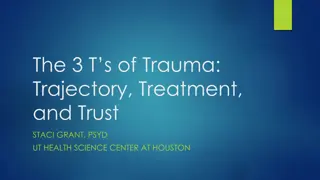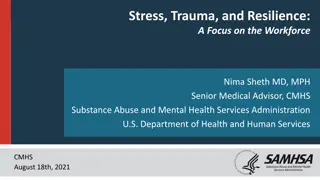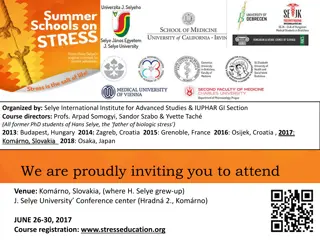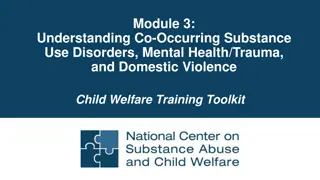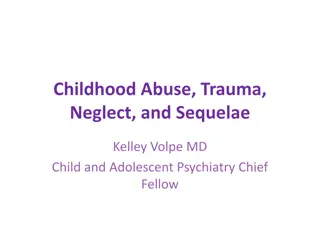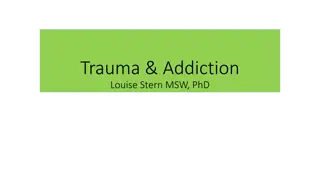Understanding Trauma and Stress-Related Disorders: A Comprehensive Overview
Trauma and stress-related disorders encompass maladaptive responses to severe stress, affecting social functioning. This article delves into classifications, specifically PTSD, emphasizing clinical presentation and management. It explores ICD-10 and ICD-11 coding, defining PTSD and its essential features. Additionally, it touches on the epidemiology of these disorders in the general population, particularly among women and those of low socioeconomic status.
Download Presentation

Please find below an Image/Link to download the presentation.
The content on the website is provided AS IS for your information and personal use only. It may not be sold, licensed, or shared on other websites without obtaining consent from the author. Download presentation by click this link. If you encounter any issues during the download, it is possible that the publisher has removed the file from their server.
E N D
Presentation Transcript
Trauma and Stress Related Disorders Dr. Alexsandra Urhi Federal Neuro-Psychiatric Hospital, Benin City 31stAugust 2022
Outline Objectives Introduction Classification Post traumatic stress disorder Clinical vignette Other trauma and stress related disorders Conclusion References 2
Objectives To understand the clinical presentation and management of trauma and stress related disorder. 3
Introduction Trauma and stress related disorders are maladaptive responses to severe or continued stress, in that they interfere with successful coping mechanisms and thus lead to problems in social functioning. 4
Classification (ICD-10)1 Coded at (F43): 1. Acute stress reaction 2. Post-traumatic stress disorders 3. Adjustment disorder . 5
Classification (ICD-11) 2 Coded at (BlockL1-6B4): 1. Post traumatic stress disorder 2. Complex post traumatic stress disorder 3. Prolonged grief disorder 4. Adjustment disorder 5. Reactive attachment disorder 6. Disinhibited social engagement disorder 7. Other specified disorders specifically associated with stress 8. Disorders specifically associated with stress, unspecified 6
Post-traumatic stress disorder (PTSD) - Definition This arises as a delayed and/or protracted response to a stressful event or situation (either short-or long-lasting) of an exceptionally threatening or catastrophic nature which is likely to cause pervasive distress in almost anyone 7
Post-traumatic stress disorder (PTSD) 3 Essential features: 1. Re-experiencing of aspects of the stressful event. 2. Hyper arousal 3. Avoidance 8
Epidemiology 4 General population: 8 out of 100 Women > men Single, divorced , widowed, socially withdrawn, or of low socioeconomic level 9
Etiology Stressor Risk factors Psychodynamic factors Cognitive behavioral factors Biological factors 10
Risk factors Childhood trauma Personality disorder traits Inadequate family or peer support Female Genetic vulnerability to psychiatric illness Recent stressful life changes 11
Psychodynamic factors It hypothesized that the trauma has reactivated a previously quiescent, yet unresolved psychological conflict. Revival of the childhood trauma result in the use of defense mechanisms of repression, denial, reaction formation and undoing. 12
Cognitive-Behavioral factors They attempt to avoid experiencing it by avoidance techniques Persons experience alternating periods of acknowledging and blocking the event There are 2 phases of its development: -The trauma (unconditioned stimulus) -Through instrumental learning Some people also receive secondary gains 13
Biological factors Noradrenergic system Opioid system Corticotropin-Releasing factor and the HPA axis 14
ICD-10 diagnostic criteria for PTSD This disorder should not generally be diagnosed unless there is evidence that it arose within 6 months of a traumatic event of exceptional severity. In addition to evidence of trauma, there must be a repetitive, intrusive recollection or re-enactment of the event in memories, daytime imagery, or dreams. 15
PTSD in children and adolescents Symptoms: Repetitive dreams of the events Nightmares of monsters Physical symptoms such as stomach aches and headaches Re-experiencing aka traumatic play Reenactment 16
Treatment The major approaches are: 1. Support 2. Encouragement to discuss the event 3. Education about coping mechanisms like relaxation. 4. Drugs: SSRIs, buspirone (a serotonergic), MAOIs (phenelzine, trazodone), anticonvulsants (carbamazepine , sodium valpraote) 17
Psychotherapy Behavior therapy Cognitive therapy Family/group therapy Eye movement desensitization and reprocessing (EMDR) When PTSD has developed, two major psychotherapeutic approaches can be taken 18
Psychotherapy 1. Exposure therapy: it has four main parts: - Education about the treatment - Breathing retraining for relaxation - Imagined exposure through repeated discussion with therapist - Exposure to real world situations related to the trauma 2. Stress management: relaxation techniques and cognitive approaches to coping with stress. 19
Differential diagnosis Panic disorder Generalized anxiety disorder Dissociative disorders 20
Course and prognosis If untreated: -30% recover completely -40% with mild symptoms -20% with moderate symptoms -10% remained unchanged or become worst. PTSD that is comorbid with other disorders is often more severe and perhaps more chronic and maybe difficult to treat. 21
Acute stress reaction 2 The disorder is similar to PTSD in many aspects like the occurrence after exposure to a traumatic event, with similar symptoms The difference is only the duration of the illness. It typically begins immediately after the trauma, and persists for at least 3 days and up to a month. 23
Adjustment disorder 2 States of subjective distress and emotional disturbance, usually interfering with significant life change or to the consequences of a stressful life event. Typically, the stressor involves financial issues, medical illness, or relationship problem. Depressed mood, anxiety, worry, a feeling of inability to cope, plan ahead or continue in the present situation and some degree of disability in the performance of daily routine. 24
Complex post traumatic stress disorder 2 A disorder that develops following exposure to an event or series of events of an extremely threatening or horrific nature, most commonly prolonged or repetitive events from which escape is difficult or impossible Diagnostic criteria for PTSD must be met plus: 1) Severe and pervasive problems in affect regulation 2) Persistent beliefs about oneself 3) Persistent difficulties in sustaining relationships and in feeling close to others. 25
Prolonged grief disorder 2 A disturbance, in which following the death of a partner , parent, child or other person close to the bereaved, there is persistent and pervasive grief response characterized by longing for the deceased or persistent preoccupation with the deceased accompanied by intense emotional pain. The grief response occurs for an atypically long period of time It clearly exceeds expected social, cultural or religious norms for the individual s culture and context. 26
Reactive attachment disorder 2 Characterized by grossly abnormal attachment behaviors in early childhood, occurring in the context of a history of grossly inadequate child care (e.g. severe neglect, maltreatment). Even when an adequate primary care giver is available, the child does not turn to the primary caregiver for comfort , support and nurture Rarely displays security-seeking behavior towards any adult, and does not respond when comfort is offered. Diagnosed in children, however, cannot be diagnosed below the age of 1 27
Disinhibited social engagement disorder 2 Characterized by grossly abnormal social behavior, occurring in the context of a grossly inadequate child care (e.g. severe neglect institutional deprivation) The child approaches adults indiscriminately, lacks reticence to approach. will go away with unfamiliar adults. Exhibits overfamiliar behavior towards strangers. Diagnosed in children, however, cannot be diagnosed below the age of 1 28
Conclusion Thank you 29
References ICD-10 Version:2019 [Internet]. icd.who.int. Available from: https://icd.who.int/browse10/2019/en#/F43.1 ICD-11 for Mortality and Morbidity Statistics [Internet]. icd.who.int. Available from: https://icd.who.int/browse11/l- m/en#/http%253a%252f%252fid.who.int%252ficd%252fentit y%252f2070699808 Shorter Oxford Textbook Of Psychiatry 7th Edition [Internet]. Internet Archive. Available from: https://archive.org/details/shorter-oxford-textbook-of- psychiatry-7th-edition_202008 Kaplan & Sadock s Synopsis of Psychiatry [Internet]. shop.lww.com. [cited 2022 Aug 28]. Available from: https://shop.lww.com/Kaplan---Sadock-s-Synopsis-of- Psychiatry/p/9781975145569 1. 2. 3. 4. 30






